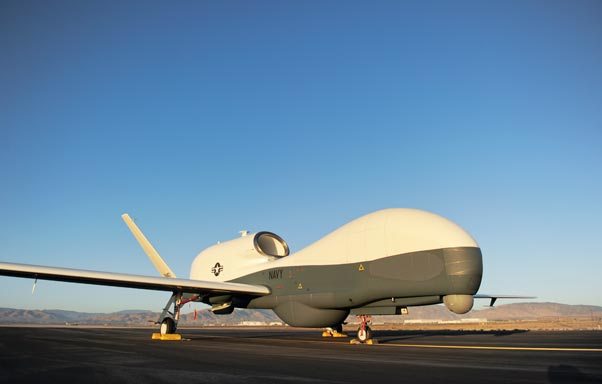The unmanned aircraft community received its first glimpse of the U.S. Navy’s MQ-4C Broad Area Maritime Surveillance (BAMS) unmanned aircraft system (UAS) during an unveiling ceremony June 14 at Northrop Grumman’s Palmdale, Calif., manufacturing plant.
“Last year, we proudly celebrated the centennial of naval aviation–this year we have seen the rollout of a new patrol aircraft and now, the beginning of an unmanned tradition in our fleet with the rollout of BAMS,” said Vice Chief of Naval Operations Adm. Mark Ferguson who spoke at the unveiling. “BAMS is uniquely suited to meet the demands of the maritime environment and give us the advantage we will need in the future–history will record this introduction as a milestone in the second hundred years of naval aviation.”
Now officially called the Triton, the MQ-4C’s unveiling caps more than four years of development with Northrop Grumman for the surveillance aircraft. The Triton will be an adjunct to the P-8A Poseidon as part of the Navy’s Maritime Patrol and Reconnaissance Force family of systems.
“It’s a phenomenal event to see the fruits of our labor come to fruition after four years of hard work and dedication to this program,” said Capt. James Hoke, program manager for the Persistent Maritime Unmanned Aircraft Systems Program Office (PMA-262), which manages the Triton program. “We are looking forward to continuing testing and evaluation, parts assembly and installation and radar risk-reduction tests.”
The next steps for the Triton program involve continued testing, functional requirements review and first flight for the system development and demonstration (SDD-1) aircraft. SDD-2 will follow a few months behind SDD-1.
The Triton air vehicle, which has a 130.9-foot wingspan, is based on the Air Force’s RQ-4B Global Hawk, while its sensors are based on components and systems already fielded in the Department of Defense inventory. The Triton’s new features include the AN/ZPY-3 multi-function active-sensor (MFAS) radar system, the primary sensor on the Triton. The MFAS completed first flight in December aboard a Gulfstream aircraft.
With the MFAS radar’s capabilities, the Triton will be able to cover more than 2.7 million square miles in a single mission. The Triton’s capability to perform persistent intelligence, surveillance and reconnaissance with a range of 2,000 nautical miles will allow P-8A, P-3C and EP-3E aircraft to focus on their core missions, adding to the capability of the Navy’s Maritime Patrol and Reconnaissance Force.











